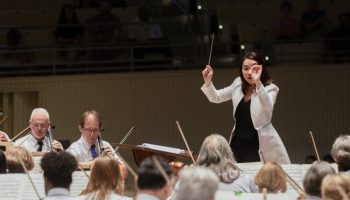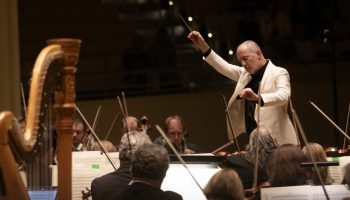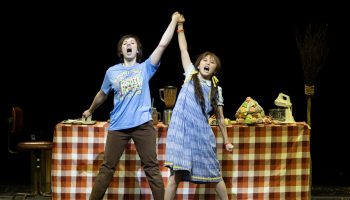Suite No. 1 from L’Arlésienne
Georges Bizet
French composer Georges Bizet was born in Paris on Oct. 25, 1838, and died in Bougival (near Paris) on June 3, 1875. Although his compositional output was wide ranging, he is best known and loved for the opera, Carmen (1874), which stands as one of the most popular and frequently performed works in the repertoire. His incidental music to Alphonse Daudet’s play, L’Arlésienne (The Girl from Arles) was first performed on Oct. 1, 1872, at Paris’ Vaudeville Theatre. From this larger composition, the composer subsequently extracted an orchestral suite, which has found favor in the concert hall. The first performance of Suite No. 1 took place at a Pasdeloup concert on Nov. 10, 1872. The Suite No. 2 was arranged and published by Ernest Guiraud in 1879, four years after Bizet’s death. Suite No. 1 is scored for two flutes, two oboes, two clarinets, one alto saxophone, two bassoons, four horns, two trumpets, two pistons, three trombones, timpani, harp or piano.
Georges Bizet’s fame rests on a remarkably small number of compositions, although one of them, the opera Carmen, yielded more than its share of “hit” tunes. Whereas Carmen is performed widely throughout the world, a complete production of Daudet’s play L’Arlésienne, with its incidental music by Bizet, is quite rare (the same might be said for Ibsen’s Peer Gynt, for which the Norwegian composer Edvard Grieg provided much memorable music).
Music lovers can be grateful for Bizet’s foresight in extracting a four-movement suite from the 27 musical numbers that comprise his incidental music. Moreover, audiences’ enjoyment of the suites is in no way hindered by ignorance of the plot of the play for which these movements were composed.
For those who wish to know, the play (itself derived from a short story by Daudet) was a flop and was withdrawn after 21 performances. The story is actually quite sad, dealing with the infatuation of a young man (Frederi) for a young Provencal girl. He is driven to madness and, despite his family’s efforts, commits suicide when he learns of her infidelity.
The Suite No. 1 begins with a prelude, marked Allegro deciso, which served as the overture to the entire play. Its vigorous opening tune is derived from a pre-existing source, “March of the Kings,” that Bizet found in a collection of folk-music published by Vidal of Aix in 1864. This tune, in its major mode iteration, was used by the 17th-century French master Jean-Baptiste Lully as the “Marche pour les Régiments de Turenne.” This followed by the theme associated with the character L’Innocent (the brother of Frederi) and concludes with music of Frederi himself.
The tuneful second movement is a graceful minuet, Allegro giocoso. The third movement is a highly expressive Adagietto in F-major that highlights the string section of the orchestra, not unlike the movement from the Symphony No. 5 of Gustav Mahler with the same tempo marking, albeit Bizet’s movement is much shorter. The final movement, Carillon, Allegro moderato, opens with a repeated figure in the horns that imitate the tolling of bells, followed by a graceful middle section. Toward the end, the horns begin, slowly at first, to bring back the bell motive as the movement picks up speed to its original tempo and ending in a flourish.
Shéhérazade
Maurice Ravel
Maurice Ravel was born March 7, 1875, to parents of Swiss and Basque descent in Ciboure, Basses-Pyrénées. He died Dec. 28, 1937 in Paris. Within a period of four years, the composer penned two works titled Shéhérazade. The earlier of the two was an “Overture de féerie,” composed in 1898 and which remained unpublished until 1975 — a full 100 years after the composer’s birth and 38 after his death. It was originally intended for an opera of the same name; a project that never came to fruition. Ravel wrote a song cycle inspired by the same topic (and with the same title) in 1903 using poetry by Tristan Klingsor (Léon Leclère). The first performance of the song cycle took place on May 17, 1904, with mezzo-soprano Jane Hatto as soloist and Alfred Cortot conducting at a concert of the Société Nationale de Musique in Paris. It is scored for two flutes and piccolo, two oboes and English horn, two clarinets, two bassoons, four French horns, two trumpets, three trombones, tuba, timpani, snare drum, bass drum, tambourine, triangle, glockenspiel, cymbals, gong, two harps and strings.
Maurice Ravel was one of the greatest orchestrators of the 20th century, treasured for his many contributions to the orchestral repertory. Many of these works began their life as transcriptions from works for piano (“Ma mére l’Oye, Le tombeau de Couperin”), while others were intended for balletic use (“Daphnis et Chloé,” “Boléro”). Audiences also know about his skill at creating brilliant instrumental effects from his popular orchestration of Modest Mussorgsky’s piano suite, “Pictures at an Exhibition.” The Shéhérazade, ouverture de féerie (fairy play) also began its life as a work for the stage — in this case, an opera that never came to fruition.
The model was, as its title implies, the legendary One Thousand and One Nights (or Arabian Nights), where the Sultana staves off her execution by bewitching her husband, Sultan Schariar, by means of relating each night a different tale of romance and adventure. In 1903, Ravel continued his fascination with the orient with the song cycle to be performed on this concert by the Chautauqua Symphony Orchestra.
The author of the texts was Tristan Klingsor (1874-1966), a pseudonym for Arthur Justin Léon Leclère. The pen name is a conflation of the names of two Wagnerian characters — perhaps a reflection of the influence that the German composer had on the French symbolist writers of the late 19th and early 20th century. Of Ravel’s Shéhérazade settings, Klingsor wrote:
“His love of difficulty led him to choose, in addition to L’Indifférent and La Flûte enchantée, one which, by reason of its length and narrative form, seemed the least suited for his purpose: Asie. The fact is that he was just at that time extremely preoccupied with the problem of adapting music to speech, heightening its accents and inflexions and magnifying them by into melody; and to assist him to carry out his project he asked me to read the poems out loud to him.”
Each of the songs of the cycle are dedicated by the composer to Jane Hatto (“Asie”), Madame René de Saint-Marceaux (“La flûte enchantée”) and Emma Bardac (“L’indifférent”). The music Ravel provided is wonderfully atmospheric, capturing perfectly the sensuality and dream-like meaning of the poetry in softly wafting ari-oso fashion.
A translation of the French texts of Klingsor’s poems read as follows:
Asie
Asia, Asia, Asia!
Ancient, wonderful land of nursery stories
Where fantasy sleeps like an empress,
In her forest filled with mystery.
Asia, I want to sail away on the schooner
That rides in the harbor this evening
Mysterious and solitary,
And finally unfurls purple sails
Like a vast nocturnal bird in the golden sky.
I want to sail away to the islands of flowers,
Listening to the perverse sea singing
To an old bewitching rhythm.
I want to see Damascus and the cities of Persia
With their slender minarets in the air.
I want to see beautiful turbans of silk
Over dark faces with gleaming teeth;
I want to see dark amorous eyes
And pupils sparkling with joy
In skins as yellow as oranges;
I want to see velvet cloaks
And robes with long fringes.
I want to see long pipes in lips
Fringed round by white beards;
I want to see crafty merchants with suspicious glances,
And cadis and viziers
Who with one movement of their bending finger
Decree life or death, at whim.
I want to see Persia, and India, and then China,
Pot-bellied mandarins under their umbrellas,
Princesses with delicate hands,
And scholars arguing
About poetry and beauty;
I want to linger in the enchanted palace
And like a foreign traveler
Contemplate at leisure landscapes painted
On cloth in pinewood frames,
With a figure in the middle of an orchard;
I want to see murderers smiling
While the executioner cuts off an innocent head
With his great curved Oriental sabre.
I want to see paupers and queens;
I want to see roses and blood;
I want to see those who die for love or, better, for hatred.
And then to return home later
To tell my adventure to people interested in dreams
Raising – like Sinbad – my old Arab cup
From time to time to my lips
To interrupt the narrative artfully …
La flûte enchantée
The shade is pleasant and my master sleeps
In his conical silk hat
With his long, yellow nose in his white beard.
But I am still awake
And from outside I listen to
A flute song, pouring out
By turns, sadness and joy
A tune by turns languorous and carefree
Which my dear lover is playing,
And when I approach the lattice window
It seems to me that each note lies
From the flute to my cheek
Like a mysterious kiss.
L’Indifferérent
Your eyes are soft as those of any girl,
Young stranger,
And the delicate curve
Of your fine features, shadowed with down
Is still more seductive in profile.
On my doorstep your lips sing
A language unknown and charming
Like music out of tune …
Enter!
And let my wine comfort you …
But no, you pass by
And from my doorway I
watch you go on your way
Giving me a graceful farewell wave,
And your hips gently sway
In your feminine and languid gait …
Prelude to The Afternoon of a Faun
Claude Debussy
(Achille-)Claude Debussy was born Aug. 22, 1862, in Saint- Germain-en-Laye (near Paris) and died in Paris on March 25, 1918. The score to the Prelude to The Afternoon of a Faun was completed between 1892 and 1894, with its first performance taking place on Dec. 22, 1894, with Gustave Doret directing the orchestra of the Société Nationale de Musique. The work is scored for three flutes, two oboes, English horn, two clarinets, two bassoons, four horns, two harps, antique cymbals and strings.
“Those nymphs, I want to make them permanent.
So clear
Their light flesh-pink, it hovers on the atmosphere
Depressed by bushy sleeps.
Was it a dream I loved?”
— Stephane Mallarme, opening lines of “The Afternoon of a Faun” (transl. William W. Austin)
The names of Mallarme and Debussy evoke such strong images of quintessentially French culture that it is difficult to believe that any hint of Wagnerian influence could possibly be detected in the poet’s “The Afternoon of a Faun” or in Debussy’s prelude that it inspired. Yet this influence is undeniably present. In the aftermath of Wagner’s 1861 Parisian adventure with Tannhäuser and the acrimony of the Franco-Prussian War remained powerful feelings regarding the master of Bayreuth. In French literature, these may be found within the pages of the Revue Wagnerienne, a journal to which Mallarme had contributed and that is filled with “symbolist” poetry inspired largely by Wagner’s libretto to Tristan und Isolde.
Debussy found himself, along with Mallarme, attracted to the work of another writer, Theodore de Banville, a leader of a French group known as the Parnassians, who boldly championed the Wagnerian cause in France. In 1888 and 1889, the composer made the pilgrimage to Bayreuth to hear Wagner’s Ring. Strangely, a premonition of Debussy’s prelude can be heard in the Rheindaughters’ music near the beginning of Act 3 of “Götterdämmerung.”
For all this, a perception of Debussy as a representative of a reaction against Wagner also is correct. Leonard Ratner has observed with considerable perception that what Debussy was able to gain from Wagner was the coloristic values of his scores, leaving the harmonic tension values to be exploited by Schoenberg and other Austrian/German expressionists.
Indeed, sensuous color is all-important in Debussy’s prelude, a work that represented his first triumph as an orchestral composer. The ambiguity and eroticism of Mallarme’s eclogue, the definitive version of which was published in 1887, is matched perfectly by that in Debussy’s score. Even the number of measures (110) in the prelude corresponds to the number of lines in the poem.
The period during which ideas for the prelude were germinating included the Paris World Exposition of 1889, where Debussy was fascinated by an exhibit of Javanese gamelan music. But then, exoticism was a familiar feature in much French music of the 19th century.
The alternatives to Wagner’s intensive chromaticism were found in this Asian music, as well as certain pieces by Mussorgsky, modal inflections, and whole-tone scales. Only an imagination as original as Debussy’s could take these disparate resources to form a work that sounded so astonishingly new. In the process, he had created no small revolution in the history of music.
The score to the prelude was completed between 1892 and 1894, with its first performance taking place on Dec. 22, 1894, with Gustave Doret directing the orchestra of the Société Nationale de Musique. A witness to its success was the rare occurrence of an encore. From its seductive opening flute solo (representative of the faun’s pan pipes) to the veiled muted horns and exotic cymbals at the end, this work is the very model of “impressionistic” orchestral color.
Daphnis et Chloé, Suite No. 2
Maurice Ravel
Ravel’s ballet “Daphnis et Chloé” was first performed on June 8, 1912, at the Paris Théâtre du Châtelet. The composer later extracted two suites from the full score, the second of which is the most frequently performed. It is scored for piccolo, two flutes (second doubles piccolo), alto flute, two oboes, English horn, two clarinets, E- at clarinet, bass clarinet, three bassoons, contrabassoon, four horns, four trumpets, three trombones, tuba, timpani, bass drum, cymbals, triangle, snare drum, military drum, tambourine, castanets, jeu de timbres à clavier, two harps, celesta and strings.
The full title of this composition reads as follows: “Daphnis et Chloé, Ballet en un Acte, Fragments Symphoniques, 2e Série. Lever du Jour — Pantomime — Danse Generale.” Ravel began work on this, perhaps his greatest masterpiece, in 1909 and continued work on it until its completion and first performance in Paris on June 8, 1912. The choreography was by the celebrated Mikhail Fokine and the dancers were members of Sergei Diaghilev’s famous Russian Ballet. The celebrated Nijinsky danced the role of Daphnis.
It is staggering to reflect on how many monuments of early 20th-century music owe their existence to the enterprising Diaghilev. Stravinsky’s “Firebird,” “Petrushka” and “The Rite of Spring,” Debussy’s “Jeux” and de Falla’s “Three-Cornered Hat” are but a few of the more famous examples.
Ravel’s conception of the ballet scenario differed considerably from that of his collaborators in that he wished to erect a “vast musical fresco, less scrupulous as to archaism than faithful to the Greece of my dreams …” When the ballet reached the stage, its impact was seriously weakened because of a scandal that was created only 10 days earlier by Nijinsky’s highly erotic interpretation of Debussy’s Prelude to The Afternoon of a Faun.
The popularity of Ravel’s “Daphnis and Chloe” rests largely on the two Fragments (suites) that he excerpted from the complete ballet. Of these, the second has proved to be the better known. Its content derives from the ballet’s third scene, beginning with an evocative depiction of dawn. Daphnis awakens to the colorful songs of birds, and Chloe is then brought to him. The lovers mime the story of Pan and Syrinx, with Chloe/Syrinx dancing to the piping (extended flute solo) of Daphnis/Pan. Young girls dressed as Bacchantes enter, followed by young men. All dance to the exciting “joyous tumult.”
“Daphnis and Chloe” is scored for a large orchestra and exhibits Ravel’s handling of these vast resources in a manner that is unmatched for sensuous beauty and vivid colorfulness.
Musicologist David B. Levy is a professor of music at Wake Forest University in Winston-Salem, North Carolina. He has also taught at the Eastman School of Music of the University of Rochester and the University of North Carolina School of the Arts. A Beethoven scholar, he founded the New Beethoven Research group and has lectured widely throughout the United States and Europe.
Levy will deliver a Pre-Concert Lecture at 6:45 p.m. Thursday, Aug. 2, in Hurlbut Church Sanctuary.




